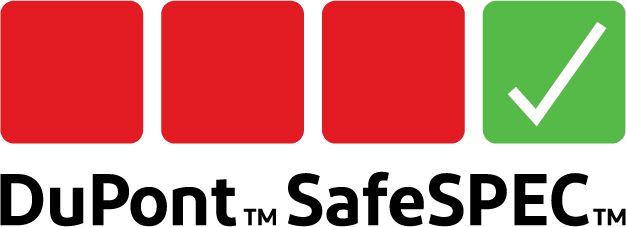Collaboration between safety training company & Tychem® Trainer Advantage Program leads to better end user experience
By Daniel Hammel
North America Marketing Lead – Chemical Industrial, DuPont Personal Protection

TEAM-1 Academy is a professional rescue & safety training company based in Ontario. The company originally was responsible for responding to chemical spills, averaging about 1,000 calls per year. During that time, TEAM-1 had a perfect safety record, never recording a single injury. Eventually, TEAM-1 shifted from hazmat response to hazmat training for companies that utilize dangerous chemicals in their operations. Now, after 1,200 training courses annually, TEAM-1 Academy can still boast their perfect zero injury safety record.
TEAM-1 Academy is a member of the DuPont™ Tychem® Trainer Advantage Program (TTAP). The program's member schools receive DuPont training suits and a Level A pressure test kit, as well as access to DuPont technical specialists and certified industrial hygienists. This allows students to train with hazmat suits that they will potentially need to use one day during a hazmat incident. Additionally, students are introduced to online selector tools on DuPont™ SafeSPEC™, which allow users to identify suitable DuPont garments and gloves for handling chemical and biological hazards.
A global manufacturer with a production facility in Canada recently hired TEAM-1 Academy to provide safety training to its crew. The manufacturing company faces multiple chemical hazards, including anhydrous ammonia. For this reason, the company already had fully encapsulated Level A suits as part of their personal protective equipment (PPE) stock.
However, it wasn't until their training sessions with TEAM-1 Academy that employees were introduced to a DuPont™ Tychem® Level A suit, specifically the Tychem® 10000. The crew was used to Level A suits with small visors and the design invoked a claustrophobic feeling. In comparison, the visor on the Tychem® 10000 looked much larger, which helped make workers feel more comfortable while wearing the Level A suit. The experience of wearing a Level A suit can be somewhat jarring, especially for people wearing it for the first time, so any design improvements that can provide relief are welcome. The trainees also liked the tapered arm of the Tychem® 10000, which allows the wearer to easily remove his or her arm from the sleeve and manipulate the meter and radio equipment near the face, while remaining in the suit.
Thanks to the introduction of the DuPont Level A offering during TEAM-1 Academy's training, the manufacturer ultimately converted their Level A suits to the DuPont offering. If you're interested in learning more about the Tychem® Trainer Advantage Program or the Tychem® 10000 suit, please contact Cory Miller at Cory.William.Miller@dupont.com.
Tychem® 2000 Tape Introduction
By Michael Sieber
Product Development Engineer, DuPont Personal Protection

Some of you might be familiar with using chemical-resistant tape or duct tape to secure the individual elements of your chemical-protective clothing ensemble. The simple act of sealing up one's gear does add a level of protection against particles, vapors, and liquids, but not all tapes are created equal, and not all are created to be used with chemical hazards. Tychem® 2000 Tape is a recent addition to the Tychem® family of products. This new chemical-resistant tape helps keep PPE in place while providing the same level of chemical resistance as Tychem® 2000 fabric. Using chemical-resistant tape as a part of your team's suite of PPE options can help secure interfaces, such as the sleeve to glove, pant leg to boot, storm flaps, or other closures. Tape options commonly used by emergency response (ER) and hazmat teams are limited—namely, options offer either high protection or offer no claims of chemical protection. This is where Tychem® 2000 Tape comes in. It fills a gap in the area for a low-hazard and easy-to-use chemical-protective tape. Current tape choices used by ER and hazmat teams can also be difficult to apply and reposition and might damage the suit if removed. Tychem® 2000 Tape tears easily for quick and convenient application, and if applied incorrectly, it is easier to reposition on most chemical-protective garments like Tychem®. The tape's elasticity enables tight adhesion to help prevent leaks. Since other tapes either make extensive or zero claims of chemical protection, this leaves health and safety managers with tough choices: leaving workers at risk of injury or having unnecessary higher PPE costs.
Tychem® 2000 Tape provides a happy medium of protection, ease of use and cost. As its name states, it provides similar chemical protection compared to the well-known Tychem® 2000 garment fabric, including chemical permeation holdout against many inorganic acids and bases used in various industries and applications, as well as common industrial cleaning agents like bleach. This includes providing at least 30 minutes of protection against more than 40 chemical challenges using the 0.1 µg/min/cm2 breakthrough criteria as specified within ASTM F739. As mentioned, it is easy to use and easy to apply, reposition or remove. Its elasticity and lack of fibrous support allows tape to be stretched for tight adhesion. Check out our web videos showing how easy it is to apply to your PPE ensemble here. It should be noted that this or any other tape will not provide a liquid- or gas-tight barrier and that garments, gloves and boots should be relied upon for the protection level that your task requires. Also, Tychem® 2000 Tape should never be used within explosive or flammable environments, similar to other PPE elements that do not have flame resistance.
Visit safespec.dupont.com to view all of the chemical permeation data for Tychem® 2000 Tape and to learn more about this innovative addition to your PPE ensemble. Also, stay tuned for the next edition of The Glow Worm, where we will discuss Tychem® 2000 Tape in more depth.
White powder incidents & first responders
By Daniel Hammel
North America Marketing Lead – Chemical Industrial, DuPont Personal Protection

First responders face a multitude of hazards. One hazard that can be a concern in both major cities and small towns is unknown white powders. These can include anthrax, fentanyl, ricin, or other hazardous substances. Many times, when suspicious white powders are found, the substance proves to be harmless, but with the surge in fentanyl usage, white powder incidents are increasingly not just the product of malicious intent or hoaxes.
First response and patient care organizations should review their response plans and procedures on how to handle white powder incidents. For first responders, several functions present the risk of being exposed, including:
- Emergency medical care of overdose victims
- Law enforcement suspect apprehension
- Clan lab/crime scene investigation & evidence collection
- Special operations & decontamination
The National Institute for Occupational Safety and Health (NIOSH) provides recommendations for PPE to protect first responders from potential exposure to hazardous drugs. The job function and potential level of exposure must be considered and quantified as described below.
- Minimal – it is suspected that hazardous drugs may be present, but none are visible
- Moderate – small amounts of hazardous drugs are visible
- High – large amounts of hazardous drugs are visible
Based on the exposure analysis, appropriate PPE needs to be selected. Nitrile gloves are recommended for all job categories, and respiratory and eye protection may be needed depending on the drug form and potential level of exposure.
For dermal protection, protective apparel is recommended when the potential level of exposure is moderate or high. Since first responders may face a variety of dangerous situations, they often use a Level B coverall that provides protection against an assortment of hazards. For example, Tychem® 6000 coveralls provide broad-spectrum protection against bloodborne pathogens (meeting ASTM F1671 industry requirements for viral penetration), chemical warfare agents, toxic industrial chemicals, and hazardous white powders and other particles. For more information related to white powder incidents and the range of Tychem® 6000 garment styles available, please contact daniel.g.bowen@dupont.com or visit SafeSPEC™.
Back to Top
Hazmat through history – Fukushima
By Kathryn Novelli
Marketing Specialist

On March 11, 2011, Japan faced an unprecedented crisis: a chain reaction beginning with the strongest earthquake in Japan's recorded history, then a tsunami, then the destruction of the Fukushima Daiichi nuclear power plant. Three of the plant's uranium fuel cores melted down, causing 11,580 square miles of Japan's mainland to be contaminated with long-lived radioactive cesium. The combined disasters resulted in the deaths of around 16,000 people.
All the land within a 12-mile radius of the power plant was destroyed. The perimeter and another 80 square miles northwest of the plant were declared too radioactive for human habitation, evacuated, and deemed a permanent exclusion zone.
Radioactive cesium has become ubiquitous in the area's ecosystem, contaminating the water, soil, plants, and animals in the exclusion zone and beyond, and has been detected in a range of Japanese foodstuffs up to 200 miles from Fukushima. The disaster also produced the largest radioactive material discharge into the ocean in history.
With nuclear byproducts taking decades, if not centuries, to naturally decay, manual remediation efforts remain imperative. Around 23,000 workers were involved in the emergency operations. In the wake of the disaster, 4 inches of topsoil and vegetation were removed, and radioactivity-displacing potassium was spread across the district. Concrete barriers were erected and an "ice wall" of frozen dirt helps to keep Pacific Ocean water from flowing around the reactor buildings and further spreading contamination.
Decontamination and maintenance efforts are ongoing. Each day, ten tons of seawater are poured on the melted cores. The resulting radioactive water is cooled, filtered, and stored. Fifty million gallons of this radioactive water have been collected and stored on site, with thousands more gallons added daily.
Despite a legacy of tragedy, life is returning to Fukushima. Ecologists have documented wild boars, raccoon dogs, birds, and other animals in the region. Furthermore, birds have shown surprising resilience with limited genetic damage from radiation, which is a potentially good sign for radioactive ecosystems in other parts of the world. "In the wake of this disaster, you realize how connected people and nature are," said Andrea Bonisoli Alquati, an environmental toxicologist at Cal Poly Pomona University.
In another symbol of rebirth, Japan plans to begin the 2021 Summer Olympics opening ceremony's torch relay in Fukushima, near the destroyed power plant, as part of Japan's "Recovery Olympics" following the devastation caused by the 2011 chain of disasters.
To find out which DuPont products offer suitable protection against hazardous radioactive particles, visit safespec.dupont.com.
Products and/or sales questions?
Share your stories, tips and tricks.

Resource library
Find technical information, videos, webinars and case studies about DuPont PPE here.


